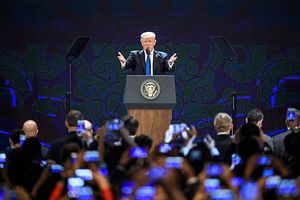This weekend, the U.S. State Department released a new progress report on the U.S. free and open Indo-Pacific (FOIP) concept in conjunction with the latest round of ASEAN-led summitry in Bangkok. While the report is just one of several inflection points in the development of the U.S. FOIP approach and is not without its limitations, it nonetheless bears careful examination in terms of what it reveals about U.S. government thinking on the evolution and future shaping of the regional vision.
Since U.S. President Donald Trump first laid out a vision for the Indo-Pacific during the Asia-Pacific Economic Cooperation summit (APEC) in Hanoi in 2017 and in line with guidance from other documents including the National Security Strategy and the National Defense Strategy, the U.S. government has been attempting to translate what has been termed “FOIP” into reality across the security, economics, and governance pillars. And that has continued on into 2019 as well, including through the release of documents such as the Indo-Pacific Strategy Report which we saw unveiled at the last iteration of the Shangri-La Dialogue (SLD) in Singapore.
Last week, the U.S. FOIP approach was in the spotlight again with the release of a new progress report. Following the pattern that we had seen with IPSR and the SLD, in conjunction with the latest round of ASEAN summitry and the holding of the 2019 Indo-Pacific Business Forum in Bangkok, the U.S. State Department released a progress report on the implementation of the U.S. government’s strategy for the Indo-Pacific region.
The 30-page report, entitled “A Free and Open Indo-Pacific: Advancing a Shared Vision,” details the state of U.S. government’s progress with respect to FOIP thus far with respect to five components: engaging partners and regional institutions; enhancing economic prosperity; championing good governance; ensuring peace and security; and investing in human capital. As U.S. Secretary of State Mike Pompeo’s introductory message in the report states, the report is not so much an interagency strategy report as it is a “implementation update” describing how the United States is working with allies and partners to implement a shared vision.
The release of new report is not without significance. Its unveiling in the midst of the latest round of ASEAN summitry reinforces the U.S. government’s emphasis on showcasing the inroads being made on FOIP to the region in spite of the challenges and uncertainties that continue to cloud it, whether it be the attention given to ongoing U.S.-China competition or questions about aspects of U.S. engagement and policy. In terms of optics, the document serves as the most comprehensive publicly released cataloging of FOIP’s progress thus far through the whole-of-government approach that U.S. officials have been rhetorically stressing thus far across several subregions within the Indo-Pacific, including South Asia, Southeast Asia, and the Pacific Islands.
Substance-wise, the report also hits on several of the right notes for usual U.S. policy. It places allies and partners at the heart of the strategy – down to the title which stresses a “shared vision” – which, much like IPSR, helps counter the perception of FOIP being an externally imposed U.S. vision. It reinforces the breadth of the FOIP approach, with attention to significant inroads made across all of the five aforementioned developments, including the elevation of the Quad to a ministerial-level meeting between the United States, Australia, India, and Japan; the launch of the Infrastructure Transaction and Assistance Network to address connectivity and infrastructure issues in the region; and a new governance program for free and fair elections in Myanmar ahead of next year’s elections. It also attempts to address some of the earlier critiques of FOIP amid the evolution of other approaches and responses, whether it be resourcing (offering some figures and metrics that indicate increased U.S. involvement since the strategy was released) or the perception that this is all about China rather than a broader U.S. approach to the region (indeed, the document remains squarely focused on advancing U.S. policy rather than merely critiquing China, with China and the PRC only getting six mentions total in the entire document, mostly in the governance and the security sections).
At the same time, there are limits to what the report can and can’t reveal and accomplish for U.S. Asia policy. For one, while the progress report does provide a more comprehensive, interagency update on the state of the FOIP approach optics-wise, it still cannot serve as a substitute for the lack of a publicly released single centralized strategy document which would further reinforce the whole-of-government approach being undertaken. For another, while the document itself may be meant partly to reinforce U.S. regional commitment, the context within which it was released – amid low-level diplomatic representation from the United States at Asian summitry and with parts of the region in wait-and-see mode ahead of U.S. elections next year – cannot but complicate its ability to accomplish its objective. Furthermore, while the report may offer clarity about how the U.S. government bureaucracy intends to advance FOIP, it cannot in and of itself address the divergences between these priorities and some of the tendencies that are more specific to the Trump administration and to the president himself on areas like free trade or multilateralism.
All this does not change the fact that the document’s release constitutes another significant step in the evolution of the U.S. FOIP approach, which is in and of itself noteworthy. Nonetheless, it does mean that even as we analyze and assess the new document, we should continue to be cognizant of the broader opportunities and challenges that U.S. officials face in shaping this approach by themselves as well as in concert with external partners for the rest of 2019 and into 2020.

































